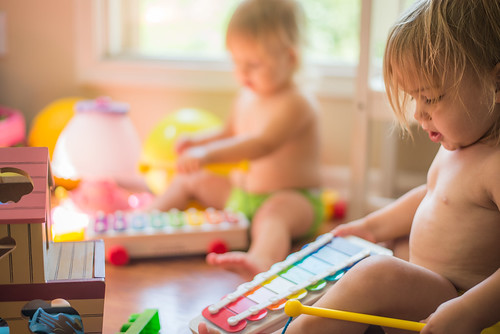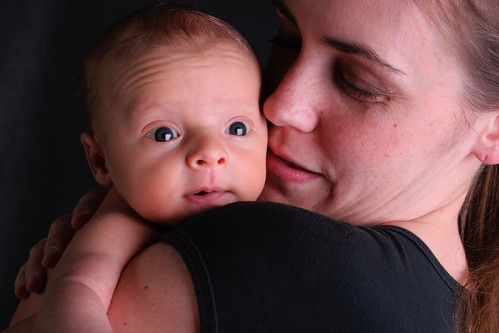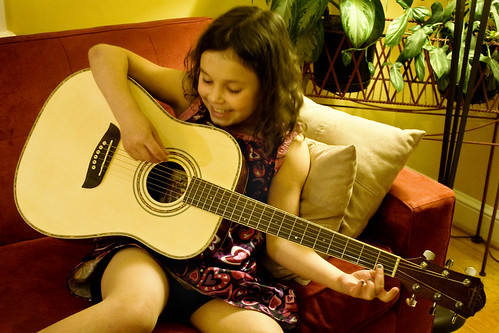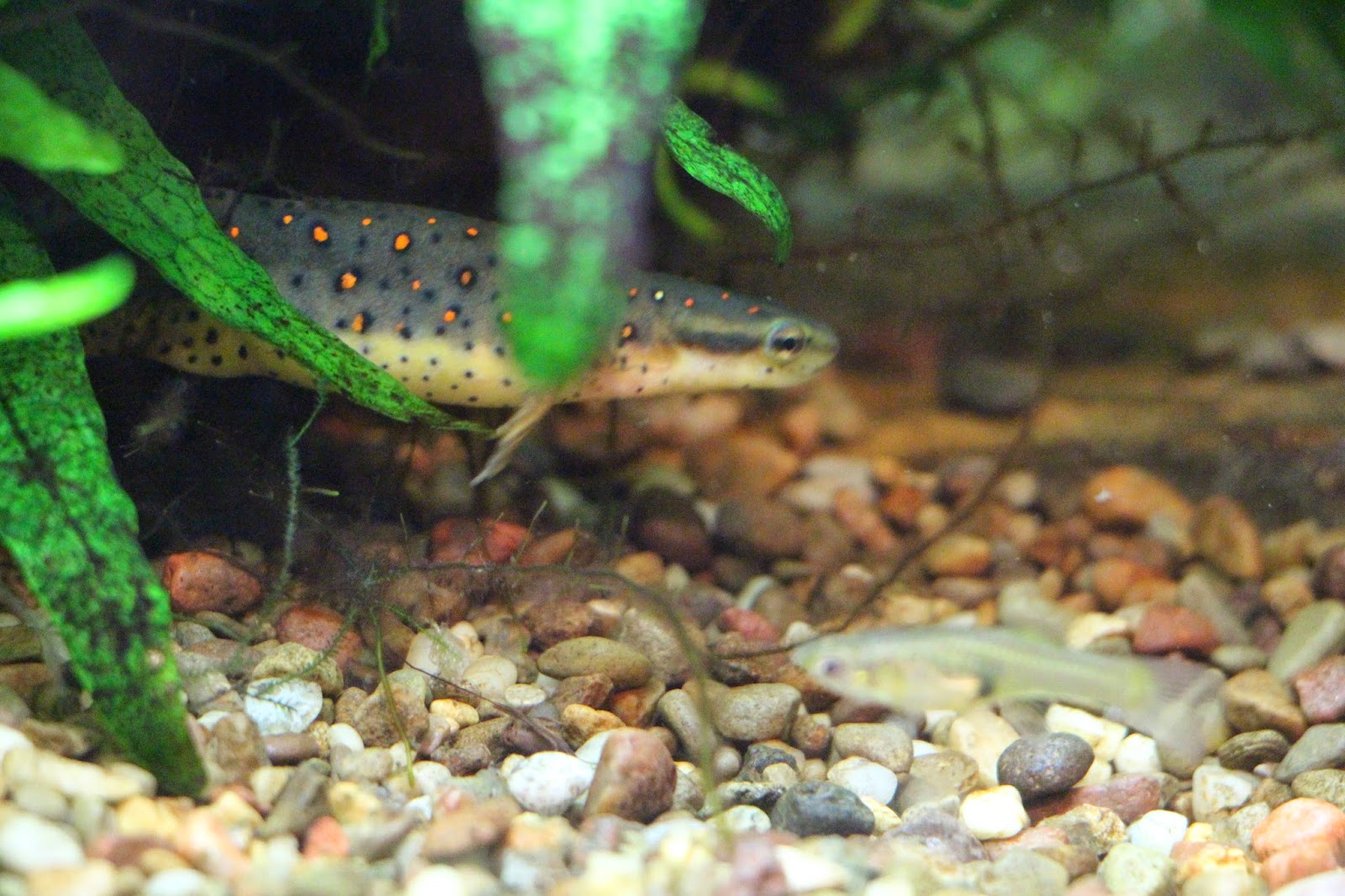A favorite milestone of many parents is when their baby starts to dance. Just take a look at Instagram's #toddlerdance for evidence and a good laugh. I remember all the attention Gummy used to get when we'd go to outdoor concerts. "Who taught him those moves?" people would ask. "Well, it wasn't me," I'd say and look in my husband's direction. I liked to pretend our son got his moves from his dad (mostly because imagining my husband dancing like that made me snicker), but really, neither of us danced anything like our energetic toddler. I secretly hoped his dancing was a sign of musical genius, or at least an indication that my son was learning something from me. But as it turns out, all babies are wired to dance.
Yes, a fun piece of research from the University of York clear back in 2010 found that we humans are born to respond to music, and rhythm specifically, it seems. My favorite observation from the research was this: "Strikingly, the more the infants were moving in time with the beat, the more they smiled."
But babies don't move naturally in time with the beat. They seem driven to, but it takes coordination, experience, and practice. That is what the preschool years of developing rhythm are all about.
Just as they differ developmentally, toddlers and preschoolers have a huge range of abilities when it comes to anything musical. They also differ in their ability to follow directions. Because of this, most experts recommend musical play for this age group. Here are some guiding principles for musical play with your children.
Steady Beat. At this age, don't worry about teaching specific rhythms. Preschoolers really just need a sense of steady beat. Young children respond most accurately to quick tempos, around 120-130 beats per minute. Tempo refers to the speed of the beat. Here is an online metronome if you'd like to know how fast that is. You want your child to be able to keep a beat at all tempos, but you can use this as a starting point. Also, if you sense your child disengaging quickly from music, try turning up the beat (tempo, not volume).
Movement through time and space. In order to move to a steady beat, children need to develop a sense of the energy required to move through a certain space within a given time. Whether they are moving their whole bodies or using a stick to hit a drum, this applies.
Cause & Effect. Toddlers are pretty much exploring this idea 24/7. It relates to the principle above, but is especially useful to guiding activities with percussion instruments or other play props. Preschoolers will need to experiment with the cause and effect of sound, energy in motion, and social responses to music.
 |
Moving to music
- Listen and keep a beat somewhere on your body. This could include bouncing up and down, patting your knees (with both hands moving together), or swaying from side to side.
- Play freeze dance. When the music goes off, everyone stop. It's a listening exercise!
- Dance to music with instructions. Use music where the choreography is sung in the lyrics (like the "Hokey Pokey" and "If You're Happy and You Know It"). This gives kids more practice with active listening, even if they aren't right on beat.
- Listen to music and count beats with or without numbers. How do you count without numbers? Use random words or movements. If you can tell that the beats of a song are organized into groups of four (we call the organization of beats meter), invent four simple movements to keep track of the four beats or use one big movement for all four beats. You might touch your head, shoulders, knees, and toes over and over in the first case. An example of the second idea would be tracing a big circle with your arm for a period of four beats, then starting again for the next set of four beats.
- Play music or sing while giving children a chance to find the beat on a percussion instrument such as shakers, bells, rhythm sticks, or a tambourine.
- Use instruments in place of hand claps and stomping to "If You're Happy and You Know It", "Bingo", and similar songs.
- Dance to music with scarves. As they watch the scarves move through the air, children can gain a sense of the time and energy between beats, especially at slower tempos.
- Pass or roll a ball from person to person following a beat. This will probably be above their level, but still fun as they try to coordinate their movements, the ball, and the pulse of the music.
- Read rhyming books with a very defined pulse.
- Read rhythmically and accent important words with your voice.
- Read and add an instrument to certain words or to the refrain. For example, if you're reading Al Perkin's Hand, Hand, Fingers, Thumb, every time you come to the "dum ditty dum" refrain, play it on an instrument. Another idea is to tell the story of the three little pigs and tap the rhythm to "I'll huff and I'll puff and I'll blow your house down" or "not by the hair of my chinny-chin-chin."
- Read with a super fast beat. Read with a super slow beat. Let your kids choose which one you do.
- Introduce symbolic music notation by playing instruments to coincide with illustrations. For example, as you read "The Very Hungry Caterpillar" tap one time for the day the caterpillar eats one apple, two times for the two pears, etc. This works really well with counting books that depict a certain number of items or animals for each number.
- Most of the reading ideas apply here too, but everything is done without visual cues. This is an important part of coordinating memory with the processes of doing. Have a favorite poem or rhyme? Have your preschooler memorize it and add creative sounds.
- Add a rhythmic transition for an activity you regularly do. Anything will work. You might say in rhythm while clapping, "It's time to eat, so let's keep a beat". Follow this up by clapping your hands to a steady beat all the way to the sink where you will wash for dinner.
- Songs like "Ring Around the Rosie", chants like "Motorboat", and games like "The Farmer in the Dell" require a lot of coordination for toddlers, but continue to be favorites. As they get older, they learn to walk on the beat in unison with other participants.
Social Rhythm
- When your toddler plays something on a percussion instrument, play the same thing back.
- After your toddler plays a pattern, play it back and add to it.
- Dance to your toddler's beat.
- Have a musical conversation. Take turns playing patterns. Don't worry if it's not in time. It's about the creative and social experience.
In case you were curious, this is how Gummy dances. I have about a million videos like this, but this one from last December is my favorite.

















.JPG)






.JPG)
.JPG)
















